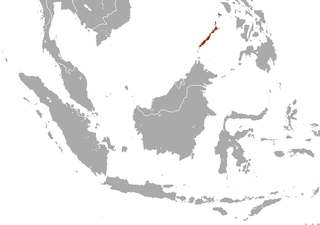
Original source: Base map derived from File:BlankMap-World.png. Distribution data from IUCN Red List
Author: Chermundy
Palawan stink badger
Order : Carnivora
Family : Mustelidae
Subfamily : Melinae
Species : Mydaus marchei
The Palawan stink badger is listed as Vulnerable (VU), considered to be facing a high risk of extinction in the wild, on the IUCN Red List of Threatened Species
Namings for the Palawan stink badger
A young / baby of a Palawan stink badger is called a 'kit'. The females are called 'sow' and males 'boar'. A Palawan stink badger group is called a 'cete, colony, set or company'.Countries
PhilippinesPalawan stink badger habitats
Artificial / Terrestrial, Grassland, Pastureland, Shrubland, Subtropical / Tropical Dry Grassland and Subtropical / Tropical Dry Shrubland
Facts about the Palawan stink badger
Occasionally, the Palawan stink badger is classified in a genus of its own, listed as Suillotaxus marchei.
The Indonesian and Palawan stink badgers are sometimes classified in two seperate subgenera: Genus: Mydaus (stink badgers) Subgenus: Mydaus (stink badgers)
The Palawan stink badger is restricted to the two Philippine Islands of Palawan and Busuanga.
The Palawan stink badger is smaller: 33-50 centimetres long, including a tail of 1-4 centimetres.
The Palawan stink badger, Mydaus marchei, is the smaller of the two species, with head-and-body lengths ranging from 320 to 460mm (plus a tail of 10 - 40mm), and weighing around 2.
There is little on record regarding the other true badger species, although it is known that the Palawan stink badger is occasionally used for food by the local population.
It does not appear that Palawan stink badgers are sexually dimorphic. (Full text)
Mydaus marchei is restricted to only 2 of the Philippine Islands. (Full text)
The Palawan stink badger, is the smaller of the two species, with head-and-body lengths ranging from 320 to 460mm (plus a tail of 10 - 40mm). (Full text)
More animals beginning with P
